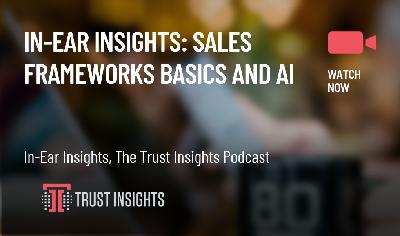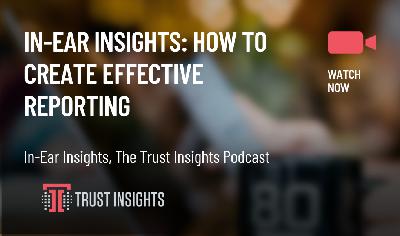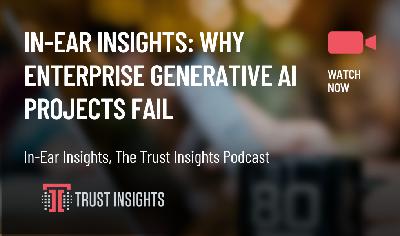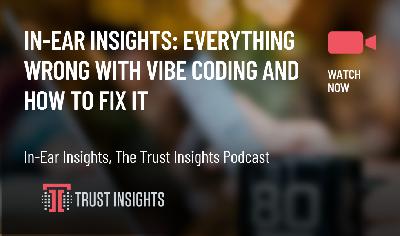In-Ear Insights: Sales Frameworks Basics and AI
Description
In this episode of In-Ear Insights, the Trust Insights podcast, Katie and Chris discuss essential sales frameworks and why they often fail today.
You will understand why traditional sales methods like Challenger and SPIN selling struggle with modern complex purchases. You will learn how to shift your sales focus from rigid, linear frameworks to the actual non-linear journey of the customer. You will discover how to use ideal customer profiles and strong documentation to build crucial trust and qualify better prospects. You will explore methods for leveraging artificial intelligence to objectively evaluate sales opportunities and improve your go/no-go decisions. Watch this episode to revolutionize your approach to high-stakes complex sales.
Watch the video here:
Can’t see anything? Watch it on YouTube here.
Listen to the audio here:
https://traffic.libsyn.com/inearinsights/tipodcast-sales-frameworks-basics-and-ai.mp3
- Need help with your company’s data and analytics? Let us know!
- Join our free Slack group for marketers interested in analytics!
[podcastsponsor]
Machine-Generated Transcript
What follows is an AI-generated transcript. The transcript may contain errors and is not a substitute for listening to the episode.
**Christopher S. Penn – 00:00 **
In this week’s In Ear Insights. Even though AI is everywhere and is threatening to eat everything and stuff like that, the reality is that people still largely buy from people. And there are certainly things that AI does that can make that process faster and easier. But today I thought it might be good to review some of the basic selling frameworks, particularly for companies like ours, but in general, to help with complex sales.
One of the things that—and Katie, I’d like your take on this—one of the things that people do most wrong in sales at the very outset is they segment out B2B versus B2C when they really should be segmenting out: simple sale versus complex sales. Simple sales, a pack of gum, there are techniques for increasing number of sales, but it’s a transaction.
**Christopher S. Penn – 00:48 **
You walk into the store, you put down your money, you walk out with your pack of gum as opposed to a complex sale. Things like B2B SaaS software, some versions of it, or consulting services, or buying a house or a college education where there’s a lot of stakeholders, a lot of negotiation, and things like that. So when you think about selling, particularly as the CEO of Trust Insights who wants to sell more stuff, what do you think about advising people on how to sell better?
**Katie Robbert – 01:19 **
Well, I should probably start with the disclaimer that I am not a trained salesperson. I happen to be very good with people and reading the situation and helping understand the pain points and needs pretty quickly. So that’s what I’ve always personally relied on in terms of how to sell things. And that’s not something that I can easily teach. So to your point, there needs to be some kind of a framework.
I disagree with your opening statement that the biggest problem people have with selling or the biggest mistake that people make is the segmentation. I agree with simple versus complex, but I do think that there is something to be said about B2B versus B2C. You really have to start somewhere.
**Katie Robbert – 02:08 **
And I think perhaps maybe if I back up even more, the advice that I would give is: Do you really know who you’re selling to? We’re all eager to close more business and make sure that the revenue numbers are going up and not down and that the pipeline is full.
The way to do that—and again, I’m not a trained salesperson, so this is my approach—is I first want to make sure I’m super clear on our ideal customer profile, what their pain points are, and that we’re super clear on our own messaging so that we know that the services that we offer are matching the pain points of the customers that we want to have in our pipeline. When we started Trust Insights, we didn’t have that.
**Katie Robbert – 02:59 **
We had a good sense of what we could do, what we were capable of, but at the same time were winging it. I think that over the past eight or so years we’ve learned a lot around how to focus and refine. It’s a crowded marketplace for anyone these days. Anyone who says they don’t really have competitors isn’t really looking that hard enough.
But the competitors aren’t traditional competitors anymore. Competitors are time, competitors are resources, competitors are budget. Those are the reasons why you’re going to lose business. So if you have a sales team that’s trying to bring in more business, you need to make sure that you’re super hyper focused. So the long-winded way of saying the first place I would start is: Are you very specifically clear on who your ideal customer is?
**Katie Robbert – 03:53 **
And are there different versions of that? Do they buy different things based on the different services that you offer? So as a non-salesperson who is forced to do sales, that’s where I.
**Christopher S. Penn – 04:04 **
would start. That’s a good place to start. One of the things, and there’s a whole industry for this of selling, is all these different selling frameworks. You will hear some of them: SPIN selling, Solution Selling, Insight Selling, Challenger, Sandler, Hopkins, etc. It’s probably not a bad age to at least review them in aggregate because they’re all very similar. What differentiates them are specific tactics or specific types of emphasis. But they all follow the same Kennedy sales principles from the 1960s, which is: identify the problem, agitate the customer in some way so that they realize that the problem is a bigger problem than they thought, provide a solution of some point, a way, and then tell them, “Here’s how we solve this problem. Buy our stuff.” That’s the basic outline.
**Christopher S. Penn – 05:05 **
Each of the systems has its own thin slice on how we do that better. So let’s do a very quick tour, and I’m going to be showing some stuff. If you’re listening to this, you can of course catch us on the Trust Insights YouTube channel. Go to Trust Insights.AI/YouTube. The first one is Solution Selling. This is from the 1990s. This is a very popular system. Again, look for people who actually have a problem you can fix. Two is get to know the audience. Three is the discovery process where you spend a lot of time consulting and asking the person what their challenges are.
**Christopher S. Penn – 05:48 **
Figure out how you can add value to that, find an internal champion that can help get you inside the organization, and then build the closing win. So that’s Solution Selling. This one has been in use for almost 40 years in places, and for complex sales, it is highly effective.
**Katie Robbert – 06:10 **
Okay. What’s interesting, though, is to your point, all the frameworks are roughly the same: give people what they need, bottom line. If you want to break it down into 1, 2, 3, 4, 5, 6 different steps because that’s easier for people to wrap their brains around, that’s totally fine. But really, it comes down to: What problems do they have? Can you solve the problem? Help them solve the problem, period. I feel, and I know we’re going to go through the other frameworks, so I’ll save my rant for afterwards.
**Christopher S. Penn – 06:47 **
SPIN Selling, again, is very similar to the Kennedy system: Understand the situation, reveal the pain points, create urgency for change, and then lead the buyers to conclude on their own. This one spends less time on identifying the customers themselves. It assumes that your prospecting and your lead flow engine is separate and working. It is much more focused on the sales process itself.
If you think about selling, you have business development representatives or sales development representatives (SDRs) up front who are smiling and dialing, calling for appointments and things like that, trying to fill a pipeline up front. Then you have account executives and actual sales folks who would be taking those warmed-up leads and working them. SPIN Selling very much focuses on the latter half of that particular process. The next one is Insight Selling. Insight Selling is a.
**Christopher S. Penn – 07:44 **
It is differentiated by the fact that it tries to make the sales process much more granular: coaching the customer, communicating value, collaborating, accelerating commitment, implementing by cultivating the relationship, and changing the insight.
The big thing about Insight Selling is that instead of very long-winded conversations and lots of meetings and calls, the Insight Selling process tries to focus on how you can take the sales process and turn it into bite-sized chunks for today’s short attention span audience. So you set up sales automation systems like Salesforce or marketing automation, but very much targeted towards the sales process to target each of these areas to say, what unusual insight can I offer a customer in this email or this text message, whatever essentially keeps them engaged.
**Christopher S. Penn – 08:40 **
So it’s very much a sales enga























